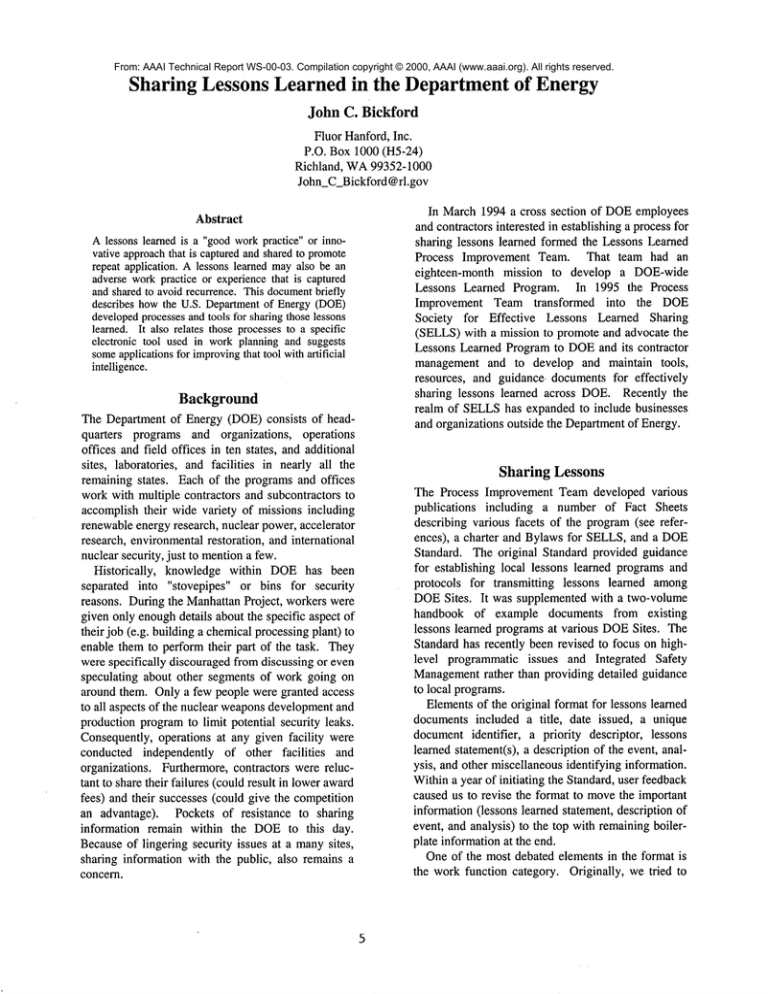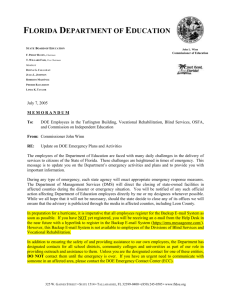
From: AAAI Technical Report WS-00-03. Compilation copyright © 2000, AAAI (www.aaai.org). All rights reserved.
Sharing Lessons Learned in the Departmentof Energy
John C. Bickford
Fluor Hanford,Inc.
P.O. Box 1000 (H5-24)
Richland, WA99352-1000
John C Bickford@rl.gov
Abstract
Alessons learned is a "goodworkpractice" or innovative approachthat is capturedand sharedto promote
repeat application. A lessons learned mayalso be an
adverse workpractice or experiencethat is captured
and shared to avoid recurrence. This documentbriefly
describes howthe U.S. Departmentof Energy(DOE)
developedprocessesand tools for sharing those lessons
learned. It also relates those processesto a specific
electronic tool used in workplanning and suggests
someapplicationsfor improving
that tool withartificial
intelligence.
Background
The Department of Energy (DOE) consists of headquarters programs and organizations, operations
offices and field offices in ten states, and additional
sites, laboratories, and facilities in nearly all the
remaining states. Each of the programs and offices
work with multiple contractors and subcontractors to
accomplish their wide variety of missions including
renewableenergy research, nuclear power, accelerator
research, environmentalrestoration, and international
nuclear security, just to mentiona few.
Historically,
knowledge within DOEhas been
separated into "stovepipes" or bins for security
reasons. During the ManhattanProject, workers were
given only enoughdetails about the specific aspect of
their job (e.g. building a chemicalprocessingplant)
enable them to perform their part of the task. They
were specifically discouraged from discussing or even
speculating about other segments of work going on
around them. Only a few people were granted access
to all aspects of the nuclear weaponsdevelopmentand
production programto limit potential security leaks.
Consequently, operations at any given facility were
conducted independently of other facilities
and
organizations. Furthermore, contractors were reluctant to share their failures (could result in loweraward
fees) and their successes (could give the competition
an advantage). Pockets of resistance to sharing
information remain within the DOEto this day.
Becauseof lingering security issues at a manysites,
sharing information with the public, also remains a
concern.
In March 1994 a cross section of DOEemployees
and contractors interested in establishing a process for
sharing lessons learned formed the Lessons Learned
Process Improvement Team. That team had an
eighteen-month mission to develop a DOE-wide
Lessons Learned Program. In 1995 the Process
Improvement Team transformed
into the DOE
Society for Effective Lessons Learned Sharing
(SELLS)with a mission to promote and advocate the
Lessons Learned Program to DOEand its contractor
management and to develop and maintain tools,
resources, and guidance documents for effectively
sharing lessons learned across DOE.Recently the
realm of SELLShas expanded to include businesses
and organizations outside the Departmentof Energy.
Sharing Lessons
The Process Improvement Team developed various
publications including a number of Fact Sheets
describing various facets of the program(see references), a charter and Bylaws for SELLS,and a DOE
Standard. The original Standard provided guidance
for establishing local lessons learned programsand
protocols for transmitting lessons learned among
DOESites. It was supplemented with a two-volume
handbook of example documents from existing
lessons learned programs at various DOESites. The
Standard has recently been revised to focus on highlevel programmatic issues and Integrated Safety
Managementrather than providing detailed guidance
to local programs.
Elementsof the original format for lessons learned
documents included a title, date issued, a unique
documentidentifier, a priority descriptor, lessons
learned statement(s), a description of the event, analysis, and other miscellaneous identifying information.
Withina year of initiating the Standard, user feedback
caused us to revise the format to movethe important
information (lessons learned statement, description of
event, and analysis) to the top with remaining boilerplate informationat the end.
One of the most debated elements in the format is
the work function category. Originally, we tried to
mimic the DOEdirectives classification
and numbering system but soon discovered that nearly all
lessons fell into the samemajor category, Operations.
Additionally, the subcategories under Operations did
not fit our needs for classifying lessons learned.
Consequently we developed a more useful list of
about 25 functional categories. At the same time, we
revised our guidance document to permit locally
assigned categories. Finally, in the December1999
revision of the Standard, we greatly expandedthe list
of categories to include manymore specific work
categories identified during five years experience with
lessons learned. This list is now used in the DOE
lessons learned database as one of four ways to sort
lessons in addition to selecting them from a chronological listing. The database search page is accessible
from the DOElessons learned web site (see references for URL).
Electronic Sharing
The Teamalso developed a number of electronic
methods for sharing lessons learned including a
listserver (an automatede-mail distribution program)
for distributing time-sensitive lessons learned, a
discussion forum (bulletin board), and a searchable
web-based database of lessons learned. These tools
are valuable elements of today’s Lessons Learned
Program. Many individual DOESites also have
developed Internet or Intranet lessons learned Web
sites. Several examplesavailable on the Internet are
listed in the references.
One aspect of the DOElessons learned process that
distinguishes it from most other databases of information is its modified "push" delivery of lessons
learned through the listserver. In manyinformation
bases, valuable lessons learned go into a "black hole,"
never to be seen again unless some potential user
actively searches for them. In contrast, SELLS
encourages Lessons Learned Coordinators to share
their lessons with the rest of the DOEby sending
them to the DOElessons learned listserver.
The
listserver forwards the lessons by e-mail to Coordinators at other DOEsites whothen further distribute
them to workers likely to need the information. See
Figure 2 for a flow diagram showing the process for
sharing lessons learned across the DOE.
Obstacles
In addition to the security concerns mentionedabove,
several other characteristics of humannature cause
lessons learned to be less effective than desired.
6
Distance is one of the most significant. The same
event (e.g. serious injury, auto accident, near miss)
will impact our behavior differently depending on
whois involved and where it occurs. Rankedroughly
in order of impact: an event that involves us, one that
involves someone we know, one that occurs across
town, and finally one that occurs across the country or
around the world. Because DOEsites are scattered
across the country, workers at the Hanford Site in
WashingtonState appear to be less impressed with a
lessons learned from the SavannahRiver Site in South
Carolina than one from their ownfacility.
Resistance to change causes manynew programs to
fail. It certainly hamperedwide spread acceptance of
the DOE Lessons Learned Program. Many employees accustomed to sharing their lessons learned
solely by wordof mouthwere reluctant to participate
in a new way of sharing. Fortunately the program
was strongly supported by dedicated employeesin the
field who kept it going through several changes in
senior managementin the DOE.A strong effort to
involve workers in the field, to give credit to those
submitting lessons learned, and to show workers how
lessons learned can make their jobs easier helped
overcomethis obstacle.
Mostof the present systems for distributing lessons
learned are quite effective in getting pertinent information to people whoneed it. Occasionally, however,
some recipients complain that they are overloaded
with information (i.e. are receiving too manye-mail
messages). Those concerns can generally be resolved
by a targeted distribution system in which an individual receives only those lessons he or she needs.
One of the major objectives of the DOELessons
Learned Program is to prevent accidents. Unfortunately, identifying an accident that didn’t happenis
very difficult. Accordingly, we have been struggling
to find a method for showing the monetary value of
the lessons learned program. Even with only a few
lessons learned traceable to actual dollar savings, the
programhas been well received and is nearly universally seen as a benefit to the Departmentof Energy.
Potential AI Applications
:lob planning teams presently must search through
lessons learned databases to find lessons applicable to
the job they are planning. Intelligent searches for
appropriate lessons learned could significantly reduce
their workload. A potential design for such a system
enhancement could match word patterns in the job
description with words in lessons learned titles or
could simply match key words in the lessons learned
with similar words in the work description. A more
sophisticated search mechanism could even match
concepts in the work description with concepts in
lessons learned. Such an advance would be a giant
step forward from the present practice of sorting and
indexing lessons into discreet categories of work,
hazards, or priority descriptors. See Figure 1 for a
conceptual flow chart of this proposedprocess.
Develop Job )
Colonial Pipeline, and the Department of Transportation are someof the entities represented in SELLS.
A long term goal of SELLSis to becomea nationally
recognized professional society.
References
DOELessons Learned WebSite:
http://www.tis.eh.doe.gov/ll/index.html
escription
"abe"
DOE-STD-7501-99,The DOECorporate Lessons
Learned Program,
http://www.tis.eh.doe.gov/techstds/standard/std7501/s
td750199.pdf
Plan,.lob
Hanford Lessons Learned WebSite:
http://www.hanford.gov/lessons/sitell/sitehome.htm
4,
Produce Work I
Figure 1 AI Search Concept
A user-friendly system could help alleviate one of
the most significant shortcomingswith current lessons
learned programs - people don’t bother to consult
applicable lessons learned before beginning a task.
This tendency results in many lessons being relearned. Simplifying and even automating the process
for retrieving applicable lessons, will increase the
likelihood that people will actually use themin their
daily activities.
The collection of DOElessons learned is relatively
small at this point so our present search mechanism
is
adequate. As the database grows, however, we will
need a more efficient way to reduce the effort
required to find pertinent lessons. Simple word
searches mayyield so manymatches that the average
user will be seriously intimidated by the sheer volume
of information he or she must manually sift through.
Several sophisticated analysis tools and search
engines currently available could potentially help
resolve this issue.
National Recognition
With several commercial businesses developing
lessons leamed programs, SELLSis expanding its
membership to include people from outside the
Departmentof Energy. The Port of Seattle, Motorola,
Oak Ridge Lessons Learned WebSite:
http://qualserve5.y 12.doe.gov/IssuesMan/externLesso
n/extemLesson.htm
SELLSFact Sheets:
http://www.tis.eh.doe.gov/ll/sells/faq.html
SELLSMeeting Report, March 1999:
http://www.tis.eh.doe.gov/II/sells/proceedings399.htm
8






